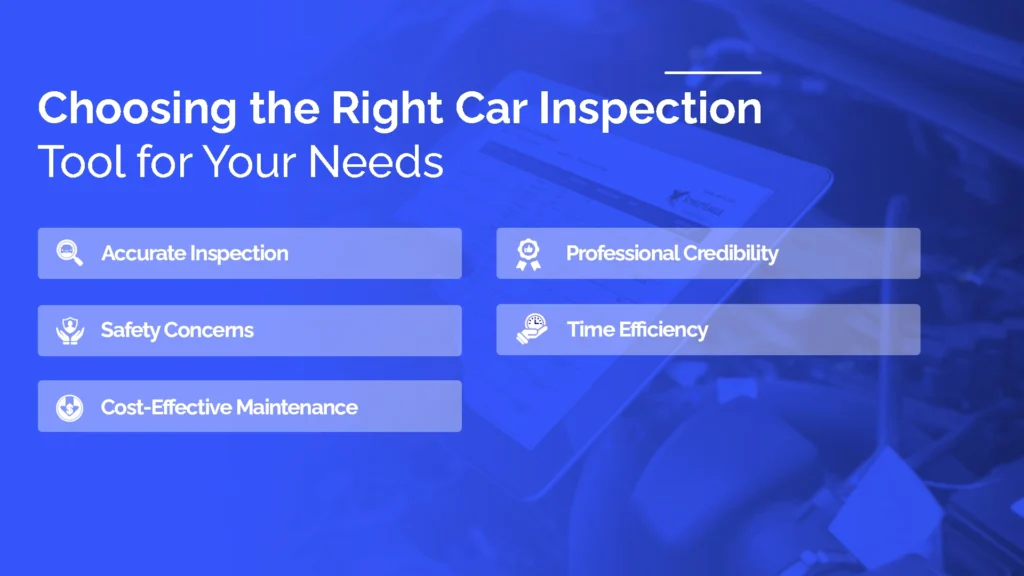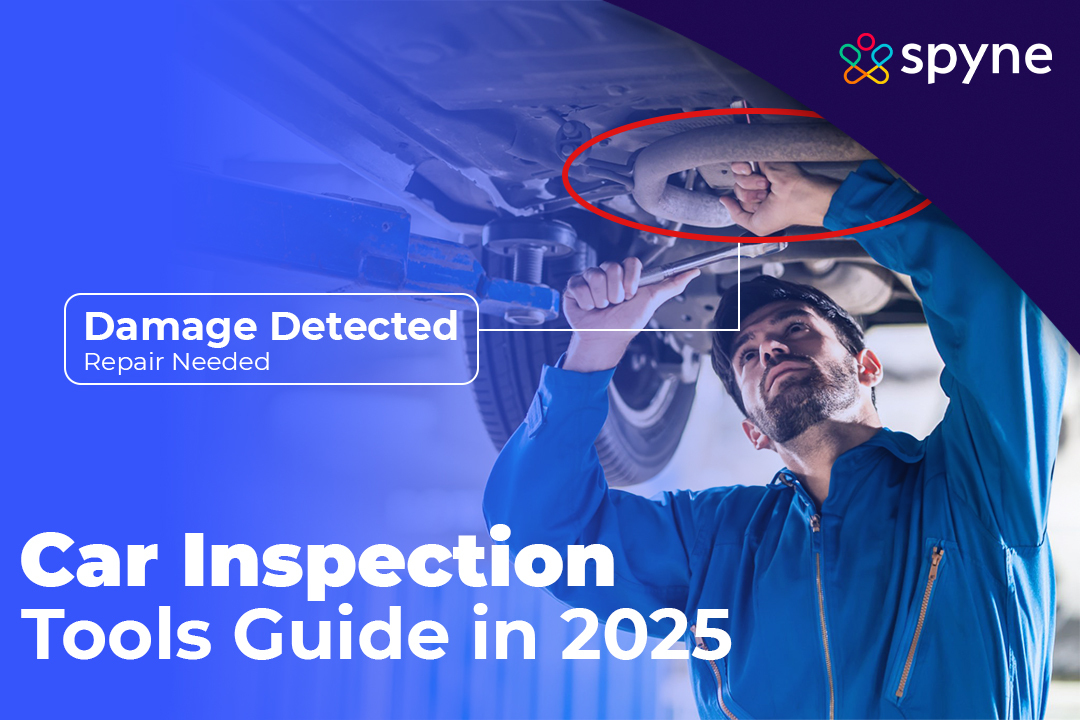Taking care of your car is very important to keep it running safely and smoothly. Whether you’re a skilled mechanic or just starting as a car owner, having the right car inspection tools is a must for good maintenance. In this blog, we’ll go over five important car inspection tools every car owner should have. These tools will help you find problems early, saving you time and money on repairs.
What are Car Inspection Tools?
Car inspection tools are important for any auto repair shop to run smoothly and effectively. With the right vehicle inspection tools, you can keep a detailed record of each vehicle’s history, which is key to understanding its value. From inspection and car diagnostic check tools to VIN reports, these tools help track repairs, check off tasks, and handle car inspections in-house without needing outside help. High-quality, affordable car inspection machines make it easier for you to manage repairs and get results faster.

5 Must-Have Tools for Complete Auto Inspection
When it comes to vehicle damage tagging and diagnosing car issues, having the right car diagnostic check tools is key. Here are five must-have tools to make auto inspections faster and more accurate:
1. Laptop or Computer with USB
Many cars since 1996 have an OBD II port that connects to car inspection tools through a USB. Using auto scan tools like Torque or ScanMaster, you can easily check for engine issues, transmission problems, and more without removing any parts. This simple setup is one of the most valuable car check up devices around.
2. Tachometer
A tachometer helps gauge an engine’s health, showing if it has high mileage or has worn parts. Since newer cars rely on an ECU to manage fuel and timing, a tachometer is important to know if the engine’s “brain” may need replacement.
3. Jumper Wire Kit
With a jumper wire kit, you can quickly test electronic components without having to remove them. These tools save time and are very helpful for testing sensors, wires, and small connections.
4. Code Reader or Scanner
A code reader is one of the simplest automotive scan tools for quick inspections. It reads engine codes to find issues in cars made after 1996 and is a go-to tool at many repair shops for its speed and ease. Many used car diagnostic checks also come with added features for better diagnostics.
5. Automotive Stethoscope
Though unusual, an automotive stethoscope lets you listen to each cylinder’s firing, checking the fuel and air mixture before ignition. It’s a fantastic way to detect issues and ensure the engine is running smoothly.
Tools for Safety and Emissions Inspections
When it comes to keeping cars safe and making sure they meet emissions standards, having the right car inspection tools is very important. Here is a car inspection tools list that can help you do thorough checks:
1. Ball Joint Gauge – CE3D103
This tool helps you check the condition of your car’s ball joints. Good ball joints are important for safe steering and a smooth ride.
2. Digital Brake Drum Gauge
Use this gauge to measure how thick your brake drums are. It’s important to make sure they’re still safe to use.
3. Brake Lining Gauge for Riveted Brakes and Tire Tread Gauge
This handy tool checks the wear on brake linings and measures tire tread depth. Keeping an eye on these helps keep your vehicle safe.
4. Digital Brake Rotor Gauge – CE3M430A
This gauge gives you a clear digital reading to measure the thickness of brake rotors. It’s important to know when they need to be replaced.
5. Emissions Test and Exemption Fee Sign
This sign is important for your inspection station. It clearly shows the fees for emissions tests, helping you stay in line with regulations.
6. Digital Tire Tread Depth Gauge
Easy to read, this gauge measures tire tread depth to ensure your tires have enough grip for safe driving.
7. Tire Pressure Gauge for Cars and Trucks
This tool measures tire pressure accurately and helps you make sure your tires are properly inflated for a safe ride.
8. Sniper Headlight Aimer
This tool helps you aim your headlights correctly and makes sure you can see well when driving at night.
9. Vehicle Equipment and Inspection Regulations Guide
This guide keeps you updated on the rules for safety inspections so you know what to look for.
10. 3-Hole Paper Punch
A simple tool for organizing your inspection logs. It makes it easy to keep track of all your essential paperwork.
Choosing the Right Car Inspection Tool for Your Needs
Having the right car inspection tools is very important for used car dealerships and buyers. Good tools help them find problems with cars quickly and accurately, which leads to safer driving. Here’s why choosing quality automobile diagnostics tools matters:

Accurate Inspection
Advanced automotive car scanner tools can quickly find specific problems in a car’s complex systems. This means no more guessing or wasting time on repairs that aren’t needed.
Safety Concerns
Finding safety hazards early, like worn-out brakes or broken lights. Good inspection tools help mechanics catch these issues before they turn into dangerous accidents.
Cost-Effective Maintenance
Detecting problems early means that minor issues can be fixed before they become big, expensive repairs. This saves car owners a lot of money in the long run.
Professional Credibility
Using high-quality vehicle diagnostic tools shows customers that you know what you’re doing. It builds trust and helps you stand out as a reliable mechanic.
Time Efficiency
Specialized tools can make inspections faster. This lets mechanics help more customers in less time, making everyone happy.
Top Features to Look for in Car Inspection Tools
When it comes to car inspection tools, not all of them work the same way. To make sure you’re getting the best ones, look for these top features that help mechanics do a thorough job:
Seatbelt Check
Good tools should help you check if seatbelts are working properly. They’re very important for keeping everyone safe in the car.
Tire Inspection
Make sure your car inspection tools can check tire tread depth and pressure. Properly inflated and good tires are important for safe driving.
Horn
A working horn is important for signaling other drivers. Tools should help you quickly test the horn to ensure it’s loud and clear.
Steering and Suspension
Look for tools that can check the steering and suspension systems. They help ensure the car handles well and rides smoothly.
Brake System Inspection
Brake checks are a must. Tools should help you inspect brake pads, rotors, and fluid levels to keep stopping power strong.
Battery Voltage Check
A good battery is key for starting a car. Make sure your tools can measure battery voltage to catch any potential issues.
Exterior Inspection
Tools that help check the car’s exterior for dents, scratches, and rust can keep it looking great and safe.
Fluid Levels
You want to keep an eye on engine oil, coolant, and other fluid levels. Good tools should make it easy to check these.
Lights and Signals
Make sure all lights and signals are working. Your car inspection tools should help you test headlights, taillights, and turn signals.
Windshield and Wipers
Good visibility is essential for safe driving. Tools should help you check the condition of the windshield and wiper blades.
Defrosters and Heating
Make sure the defrosters and heating system are functioning. Good inspection tools can help you test these to keep passengers comfortable.
Exhaust System
Tools should also help you check the exhaust system for leaks or damage, keeping emissions in check and the car running smoothly.
Benefits of Using Car Inspection Tools
Car inspection tools help save money and time and prevent expensive repairs by finding problems early. Using the right vehicle inspection equipment can provide you with these benefits:
1. Prevent Expensive Repairs
Small problems can turn into big, costly repairs when ignored. Car inspection tools find hidden faults early, making repairs quicker and cheaper.
2. Make Smart Used Car Purchases
A car inspection machine helps find hidden damage and mechanical issues before buying a used car. A full check ensures a fair price and avoids unexpected repair costs. The used car inspection price is always lower than fixing major issues later.
3. Speed Up and Improve Vehicle Checks
Vehicle inspection tools make checks fast and accurate. Technician inspection tools help mechanics quickly diagnose issues, reducing wait times and improving service quality.
4. Build Customer Trust
Auto shops using top-rated agency inspection tools provide detailed vehicle inspection reports with photos. Customers can see exactly what needs fixing, increasing trust and satisfaction.
5. Reduce Recurring Car Problems
Without the right car inspection device, some issues can be misdiagnosed or overlooked. Vehicle check tools find the real problem, making sure repairs fix the issue completely.
6. Detect Problems Before They Happen
Vehicle inspection machines with AI and sensors spot wear and tear patterns, identifying parts that need replacement before they fail.
7. Improve Road Safety
Safety inspection tools detect problems like worn brakes, weak steering, and damaged tires before accidents happen. Maintenance inspection tools keep fleets running safely.
8. Keep Accurate Vehicle Records
Digital vehicle inspection products store records of past checks, repairs, and maintenance. This helps track vehicle history and plan future repairs.
9. Speed Up Repairs and Reduce Downtime
Professional vehicle inspection tools help mechanics find issues fast. A car inspection tool eliminates guesswork, making repairs quicker and more efficient.
10. A Smart Investment for Car Owners and Auto Shops
Vehicle inspection products help detect problems early, improve efficiency, and increase customer trust. Car inspection tools keep cars in top condition, preventing breakdowns and saving money.
Automated vs. Manual Vehicle Inspections
When checking a car’s condition, there are two main ways to do it: manual inspections and automated vehicle inspections (AVI). Each method has its own strengths. Let’s take a closer look.
Automated Vehicle Inspections (AVI)
Automated vehicle inspections use cameras, sensors, and AI to check a car quickly and consistently. These inspections are becoming more common because they are faster, more accurate, and cost less than manual checks.
One of the best features of AVI is the 360-degree walk-around check, which can spot tiny scratches and dents that might be missed in regular photos. AI-powered vehicle inspection tools improve accuracy, often detecting over 99% of defects. These systems are great for checking large numbers of cars quickly.
Automated quality control systems help businesses save time and catch defects at unmatched speed. Since these inspections rely on car inspection machines and vehicle checks tools, they don’t get tired or distracted, making sure consistent results.
However, AVI has some limits. Since it relies on computer vision and telematics, it cannot always detect engine problems or certain mechanical issues. That’s why it’s important to know what AVI can and can’t do.
Manual Vehicle Inspections
Manual inspections have been used for years. In this method, a trained inspector visually checks the car for damage or issues. They may use vehicle inspection equipment like flashlights, mirrors, and scanners to get a closer look. After the check, they write a report on what they found and what needs fixing.
This method takes more time and costs more. Depending on your location, a manual inspection can cost between $30 and $200. If the inspector has to travel far, the price may go up to $300 or more. Scheduling can also be difficult, and the inspection itself can take 3 to 5 hours or longer.
Manual inspections depend on the inspector’s skill and experience. A trained inspector can catch complex issues that an AI system might miss. However, manual checks can be slower, less consistent, and prone to human error. Unlike an automated car inspection device, a human might overlook small defects due to fatigue or lack of experience.
Future Trends in Car Inspection Technology
AI is Transforming Car Inspections
AI-powered vehicle inspection tools are making car inspections faster, more accurate, and more efficient. Traditional methods required manual checks, but now, car inspection machines use sensors and AI to detect issues instantly. This technology helps technicians find hidden problems early, saving time and money while ensuring better vehicle safety.
Smarter Inspections with Advanced Technology
Modern vehicle inspection equipment includes AI-driven diagnostics, predictive maintenance systems, and automated scanning. Car inspection devices now identify potential failures before they happen, reducing unexpected breakdowns. New-age safety inspection tools also offer real-time alerts, making maintenance easier for car owners and businesses.
Blockchain and Drone-Based Inspections
Innovations like blockchain ensure secure and tamper-proof records of vehicle checks tools, creating more trust in the process. Drones provide a full 360° car view, making inspections more thorough and efficient. Dealerships and businesses benefit from top-rated agency inspection tools, which speed up evaluations and improve accuracy.
Built-in Sensors for Accurate Vehicle Checks
Many modern cars come equipped with smart sensors that enhance maintenance inspection tools. These sensors track vibrations, fluid levels, and engine health, helping detect problems before they become serious. Thermal, infrared, and fiber optic sensors provide deeper insights, making vehicle inspection machines more advanced than ever.
Digital and Remote Car Inspections
Digital solutions have made vehicle inspections more convenient. Mobile apps with car inspection tools allow real-time reporting, reducing paperwork and improving efficiency. Virtual inspections via video calls help buyers and businesses assess vehicles remotely. AI-powered diagnostics also assist in determining the right used car inspection price for fair deals.
Why Spyne’s Vehicle Inspection Software Is the Best Car Inspection Tool
Spyne offers tools that make vehicle inspections easy for used car dealerships and car owners. Whether you’re selling or buying, Spyne’s car inspection tools are here to help.
Quick Vehicle Condition Reports
Spyne’s inspection tool gives you a report on your car’s condition instantly. It spots issues like dents, scratches, and worn tires in no time. This fast info helps both buyers and sellers make quick decisions.
Building Trust with Transparency
Spyne’s inspections are clear and honest. With accurate reports, customers feel confident in what they’re getting. This trust keeps them coming back for more.
360-Degree Scanning
With Spyne’s 360-degree scanning, you can check every angle of the car. This way, no detail gets missed, ensuring a complete picture of the vehicle’s condition.
Easy Access to Past Reports
Spyne keeps all your inspection and service history in one spot. This makes it easy to review past reports, helping you stay on top of the car’s health for future checks.
Sharp, Real-Time Photos
You can take high-definition photos during the inspection with Spyne’s AI. These clear images show the car’s condition perfectly, great for online car sales listings and records.
Cutting Down on Mistakes
Spyne’s automated inspections help reduce errors. The AI checks everything thoroughly so nothing is overlooked. This means better results and reliable inspections every time.
Conclusion
Owning a vehicle means having the right tools for maintenance and repairs. You can easily find these affordable car inspection tools at automotive dealerships or online. The five important tools we discussed will help keep your car or truck running smoothly for years without breaking the bank on repairs. Plus, you don’t need special skills to use them; just follow the instructions. And remember, using Spyne’s advanced vehicle inspection tools can make the process even easier. So get started today.



























